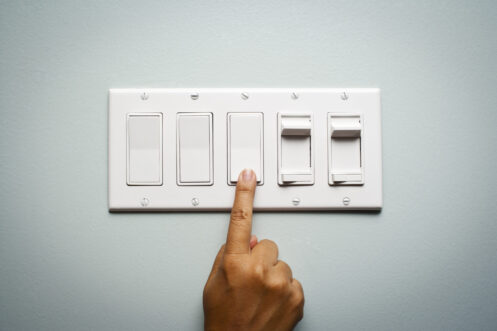Flickering lights can be annoying, but they often signal that something in your home’s electrical system needs attention. This seemingly minor issue can be a symptom of various underlying problems, ranging from simple fixes to more serious electrical issues. Understanding why your lights are flickering is crucial, as it helps you identify what’s normal and what might require immediate attention from a professional.
Loose Light Bulb or Faulty Connection
One of the most common and quickly resolved causes of flickering lights is a loose light bulb. If a bulb isn’t screwed in tightly, it can cause the filament to lose consistent contact with the socket, leading to flickering. This often happens with incandescent bulbs, but it can occur with any type of light. Simply turning off the light, tightening the bulb, and turning it back on can fix the problem. However, if the bulb continues to flicker after this adjustment, there may be an issue with the light fixture itself, such as a loose connection in the socket or wiring.
Loose connections are a common culprit, especially in older light fixtures or if a bulb has been frequently changed. A poor connection between the socket and bulb can create inconsistent contact, causing the light to flicker intermittently. If you notice this issue with multiple fixtures or bulbs, it may be worth examining whether you need to replace the fixture or have a professional check for any electrical issues.
Poor-Quality LED Bulbs or Incompatible Bulb Types
LEDs have grown immensely popular because they’re energy-efficient and have a long lifespan. However, if you’re experiencing flickering with LED bulbs, it might be due to their compatibility with the fixture or the dimmer switch. LED bulbs require specific dimmer switches designed for their technology, as traditional dimmers often don’t provide the correct voltage flow for LEDs, leading to flickering.
Additionally, not all LED bulbs are created equal. Cheaper or low-quality LEDs may be more prone to flickering, as they might need proper components to regulate the current flow. When purchasing LEDs, look for high-quality bulbs with good reviews, and ensure they’re compatible with your fixtures and any dimmer switches you’re using. This simple step can often save you from unnecessary flickering and improve the lifespan of your bulbs.
Electrical Voltage Changes
Every home electrical system in the United States has a specific voltage range, usually around 120 volts. However, when large appliances like refrigerators, air conditioners, or washing machines turn on, they can create brief but significant voltage drops in the electrical circuit, resulting in flickering lights. This flicker typically happens only when the appliance cycles on or off and should stop once it reaches a steady state.
While occasional flickering due to large appliances is regular, frequent and severe flickering can indicate a problem with your electrical system. Consistent voltage fluctuations can stress the wiring and devices in your home, leading to potential damage. If you suspect this is the cause, you might want to consider installing a dedicated circuit for high-demand appliances or have an electrician evaluate your home’s wiring to ensure it can handle the electrical load.
Worn Wiring
In older homes, outdated or worn wiring can significantly cause flickering lights. Wiring can break down over time because of wear and tear, water damage, or animal activity. When wiring becomes damaged, it can create poor connections that lead to inconsistent power flow, resulting in flickering lights or even sparking in severe cases. This is a more serious issue that should be handled by a licensed electrician.
If your home was built several decades ago and you’re experiencing flickering in multiple areas, it may be a sign that the wiring system needs an upgrade. Older wiring may not only contribute to flickering but can also pose a fire hazard, so it’s essential to have it inspected and replaced if necessary. Upgrading outdated wiring improves the safety of your home’s electrical system and can eliminate flickering caused by poor connections.
Loose Wiring in the Electrical Panel
If you’ve ruled out individual fixtures, bulbs, and overloaded circuits, the flickering may be due to loose wiring or poor connections in the electrical panel itself. Loose connections within the panel can cause lights to flicker intermittently throughout the home. Since the panel controls the distribution of power to every circuit in your house, any loose or damaged connection can affect the entire system.
This is a major problem that needs to be fixed right away by a qualified electrician. Loose wiring in the panel can create dangerous conditions, including arcing, which may lead to electrical fires. Regular electrical inspections can help identify loose connections before they become major problems, but if you’re already experiencing flickering, have your panel checked as soon as possible.
Overloaded Electrical Circuit
It’s possible for lights to flash when too many electronics are using the same circuit. This is called an overloaded circuit. This problem is common in older homes because they have fewer connections. When a circuit is overloaded, it can’t give every device attached to it a steady voltage. This causes power levels to change and lights to flash.
To resolve an overloaded circuit, try redistributing some of the devices to different circuits. You can also limit the use of high-power devices, like space heaters or microwaves, on the same circuit. If these don’t stop the flashing, you should have an expert look at your electrical panel and possibly add more lines to better balance the load.
Utility Service Problems
In some cases, the problem may not be in your home at all but rather in the utility service supplying power to your house. If there’s an issue with the local power grid, such as damaged transformers, power fluctuations, or even high demand in the neighborhood, it can cause your lights to flicker. These fluctuations are typically out of your control and may affect multiple homes in your area.
If you think there might be a problem with the utility, you can call your power company to report the dimming and find out if there are known problems in your area. Utility companies sometimes do repairs or changes that make the power less stable for a short time.
Prevent Flickering Lights
To prevent flickering lights, consider regular electrical inspections, especially if you live in an older home. An electrician can check for loose connections, faulty fixtures, and signs of wear that may lead to future flickering. Also, try to avoid overloading circuits by distributing appliances and high-wattage devices across different circuits.
Using high-quality, compatible bulbs, especially when paired with dimmer switches, can prevent flickering caused by incompatibility issues. Additionally, a surge protector can help shield sensitive electronics from voltage fluctuations, providing another layer of protection.
Contact Us Today
Flickering lights are more than just a minor inconvenience; they can be an important clue to underlying issues in your home’s electrical system. Addressing flickering lights promptly helps ensure the long-term safety and efficiency of your electrical system, preventing costly repairs or more severe risks down the line. [company_name] in Twin Falls, ID, helps homeowners with their electrical wiring and lighting. Call [company_name] when it’s time to fix your flickering lights. We also offer car charging, electrical panels, generators, indoor and outdoor lighting, drain cleaning, heating, sewer repair, and air conditioning services.


